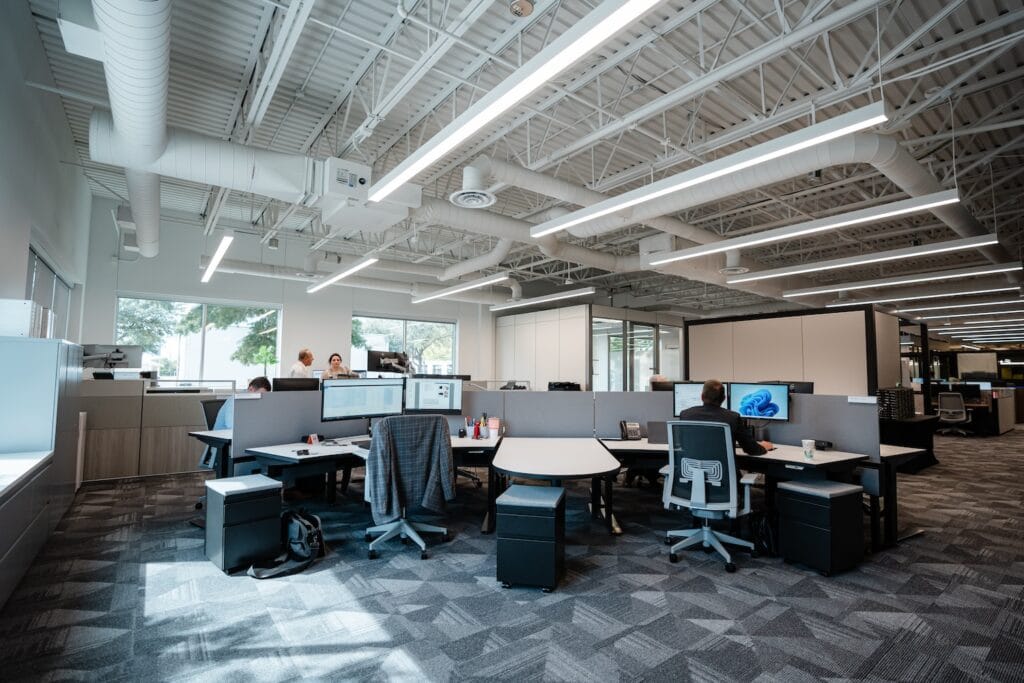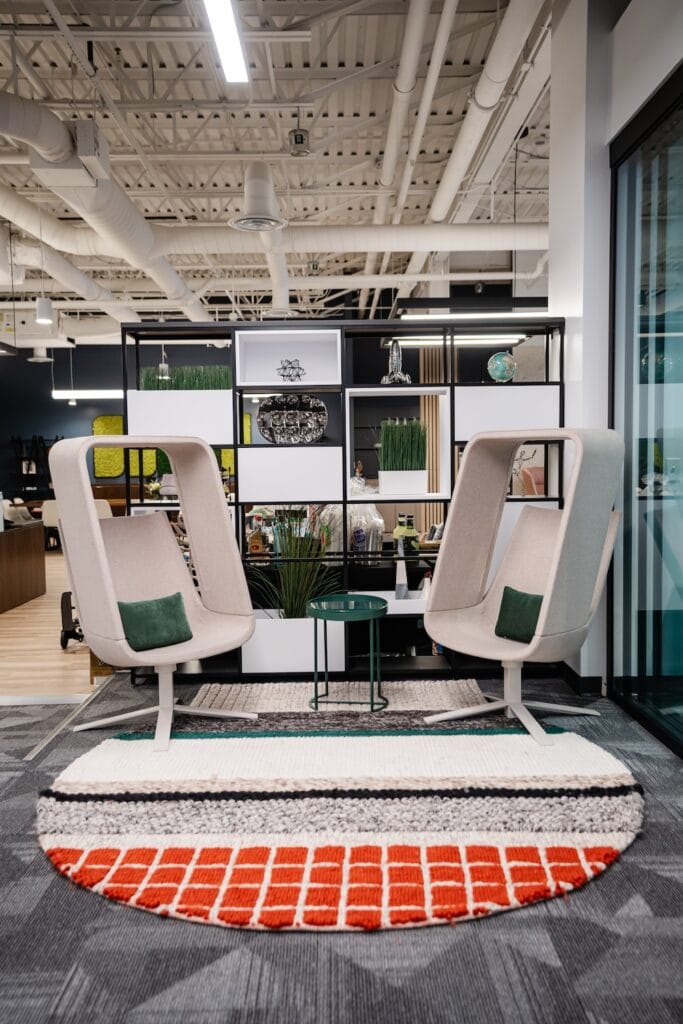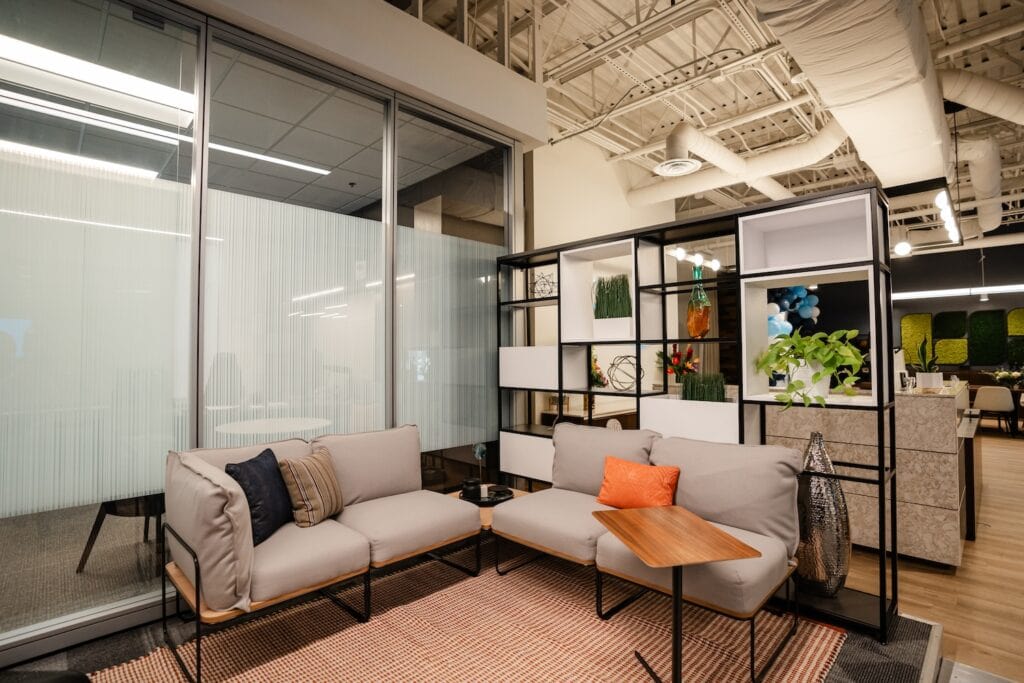In a world where technology, economic fluctuations, and recent global events have reshaped our approach to work, the design of office spaces has undergone significant transformation. This article explores how modern workplaces have evolved from the conventional cubicle setup to flexible environments catering to a diverse workforce’s needs.
Highlighting case studies from McKesson and Tesla, we examine innovative design strategies prioritizing adaptability, collaboration, and sustainability. We delve into the consultative approach to office design, emphasizing the importance of aligning spaces with a company’s unique goals and the future trends that will continue to influence how we create and utilize work environments in the era of dynamic change.
Table of Contents
The Evolution of Office Spaces and Cubicle Design
The modern office was revolutionized by the introduction of computers, leading to the widespread adoption of the cubicle. This era saw offices transform into ‘cube farms,’ where employees were stationed in a maze of cubicles to facilitate access to technology.
Economic downturns prompted companies to rethink space usage. The challenge wasn’t just to reduce space but to reimagine its purpose. How could the sprawling cubicle be downsized with shrinking technology yet still fulfill the demands of the modern workforce?

Beyond Cubicles: A New Vision for Workspaces
This period of introspection led to a holistic view of office design. Reducing individual workspace paved the way for communal areas like meeting rooms and break areas. The office evolved from a place of solitary cubicles to a multifunctional environment supporting collaboration and innovation.
The journey from dense cubicle farms to dynamic, flexible workspaces illustrates a fundamental change in the perception of office space. It’s a shift from viewing offices merely as places to house employees to creating environments that foster teamwork, creativity, and well-being.
The Role of Economic Changes and Technology in Workspace Optimization
The modern workspace has undergone a significant transformation driven by economic recession and technological advancement. Historical economic downturns have repeatedly reshaped the use of office space, compelling a reevaluation of its design and function. Similarly, modern computing has revolutionized workspace creation, departing from traditional layouts towards more innovative configurations.
The Rise of Flexible Workspaces
In response to these changes, flexibility within office spaces has emerged as a permanent fixture. The adaptability of a space—how, when, and where it is used—has become paramount. This shift acknowledges the evolving needs of the workforce and the critical role of amenities, both within and surrounding office buildings. Central business districts, once the epitome of corporate real estate, are now being reevaluated in light of their ability to meet these changing demands.
The Appeal of Suburban Workspaces
A notable trend is the growing attraction of suburban areas as prime locations for office development. These areas offer the possibility to design spaces that are not only conducive to work but are also integrated with amenities that enhance the work-life balance. The shift suggests a broader reimagining of commercial real estate’s role, particularly in central business districts, which are now challenged to adapt to support diverse work styles and activities within their ecosystems.
This evolution reflects a broader understanding that the future of workspace design lies not just in the physical space itself but in creating environments that foster productivity, creativity, and well-being. As we move forward, the interplay between economic pressures, technological advancements, and changing workforce expectations will continue to shape the landscape of office design and utilization.
Adapting to New Norms: COVID-19’s Impact on Office Design
The aftermath of COVID-19 has made flexibility an indispensable feature of modern workplaces. Offices are evolving to support dynamic workstyles and collaborative efforts, reinforcing the indispensable nature of adaptability in fostering employee growth and connectivity.
Despite a surge in remote work, the pandemic highlighted the irreplaceable benefits of in-person interactions for professional development and team cohesion. Creating office spaces that mirror the convenience and comfort of home has become a priority, aiming to lure employees back by blending the best of both worlds.
Cultivating Live, Work, Play Communities
Employers are now focusing on integrating workspaces into live, work, and play communities that minimize commute times and enhance lifestyle quality. These environments offer professional and personal amenities, encouraging a more integrated approach to work-life balance.
In essence, COVID-19 has accelerated a shift towards office designs prioritizing flexibility, personal interaction, and a holistic lifestyle, setting new standards for future workplace environments.
Future Trends in Workplace Design: Flexibility, Technology, and Sustainability
The modern workplace is adapting to cater to a workforce that spans generations, each with unique demands for collaboration, communication, and sustainability. This diversity necessitates a strategic approach to workplace design, where understanding and meeting these varied needs is paramount. The goal is to create environments that reflect the company’s vision and growth ambitions and enhance the work experience for every employee.
Prioritizing Sustainability and Technology
Sustainability has surged to the forefront of workplace design priorities, with efforts centered on carbon neutrality and utilizing sustainable materials. This shift towards eco-friendly practices matches technology’s critical role, which shapes workspaces’ functionality and flexibility. Integrating advanced tech solutions ensures that office environments can adapt to evolving work processes, making technology a cornerstone of modern workplace design.

Crafting Flexible and Adaptable Spaces
The future of workplace design lies in flexibility—creating spaces that can evolve in response to changing business models, employee needs, and technological advancements. This involves balancing private and collaborative areas, incorporating meeting rooms, and supporting various tech requirements. Companies can develop efficient, sustainable workspaces conducive to creativity, productivity, and well-being by focusing on these elements.
In navigating these trends, the challenge for businesses is to remain agile, continuously reassessing and adapting their workplace strategies to foster an environment where employees can thrive amidst the ever-changing work landscape.
Case Studies and Practical Applications: McKesson and Tesla
Understanding each organization’s unique business drivers and goals is crucial in crafting workspace solutions that align with their needs. Our approach centers on collaboration with partners to devise environments that enhance productivity and cater to the diverse requirements of a changing workforce. This strategy applies whether focusing on collaborative spaces or creating more private, heads-down work areas.
McKesson: Maximizing Flexibility in Reduced Footprint
McKesson, a leading medical supply company, faced the challenge of underutilized office space, sprawling over half a million square feet. Their strategic response was to drastically reduce their real estate costs by condensing their workspace into a 30,000-square-foot area designed for ultimate flexibility.
This new environment was equipped with advanced technology for seamless communication, adaptable workstations for executives and teams, and communal areas aimed at drawing employees back into the office by offering conveniences surpassing those found at home or in public spaces.
Tesla: Transforming Industrial Space for Work and Leisure
Tesla’s Gigafactory in Austin showcases an innovative use of space within an industrial setting. A 100,000-square-foot mezzanine, primarily used for meal breaks, is being reimagined to serve multifunctional purposes. Integrating technology, varied seating configurations, and sound masking to mitigate industrial noise transforms the area into a space where employees can collaborate, recharge, and work efficiently. This adaptation exemplifies how spaces traditionally designated for one purpose can evolve to meet a broader range of employee needs.
These case studies exemplify how a deep understanding of an organization’s goals and the specific needs of its workforce can lead to innovative and flexible workspace solutions. Whether reducing a corporate footprint like McKesson or repurposing industrial space, as seen at Tesla, the focus remains on creating environments that foster productivity, collaboration, and employee satisfaction.
The Consultative Approach to Office Design and Future Outlook
Our extensive experience and proven track record empower us to understand and reapply successful solutions across different organizations, enhancing collaboration or focusing on individual workspaces as needed. We recognize that the essence of our job transcends mere furniture selection—it’s about fostering environments that support a company’s vision and growth, considering the evolving landscape of work and the varied needs of a multi-generational workforce.
Beyond Physical Spaces
The importance of physical office space has been redefined, emphasizing the need for human interaction and personal development within a professional setting. This reevaluation speaks to the broader trend of workplace evolution, where roles traditionally confined to office spaces are reassessed in the context of their necessity for in-person collaboration and the potential for remote execution.
Customized Solutions for Future Workspaces
Acknowledging the uniqueness of each company’s requirements, our consultative approach focuses on understanding their specific business drivers and objectives. This enables us to provide tailored solutions that address current needs and anticipate future trends. Our collaboration with partners and end-users is driven by a commitment to deliver spaces that support business goals, employee well-being, and sustainable practices.
Global Perspectives and Local Applications
Leveraging global insights from our partnerships, particularly with industry leaders like Haworth, allows us to bring a wealth of knowledge. This global perspective informs our approach to designing workspaces that meet the demands of a changing workforce, integrating sustainability, technology, and flexibility. Our role as consultants is to translate these global trends into actionable strategies for our clients, ensuring their office environments are equipped to support their business now and in the future.

Conclusion
As we’ve journeyed through the evolution of workplace design, from traditional layouts to innovative, flexible environments, it’s clear that the future of office spaces is being shaped by a deep understanding of the changing needs of businesses and their employees.
The case studies of McKesson and Tesla serve as powerful examples of how adaptability, technology, and sustainability drive the creation of spaces that not only enhance productivity but also foster a sense of community and well-being. The consultative approach underscores the importance of tailoring design solutions to meet specific organizational goals, ensuring that workspaces are functional and inspirational.
As we look ahead, the ongoing dialogue between design, technology, and human experience will continue redefining our conception of the workplace, promising a future where offices are not just workplaces but environments that support the full spectrum of human potential and creativity.
Let’s Build a Partnership Together
Ready to transform your office space with more than just furniture? We offer a partnership that extends beyond the conventional. Our commitment is to understand, innovate, and collaborate with you to create solutions tailored to your unique needs. Contact us today to find out how we can row in the same direction, building a solid relationship that grows and evolves with your business.
About FMG
FMG is more than just a furniture provider; it’s a partner in designing and implementing comprehensive workplace solutions. As a Haworth Best In Class Dealer, FMG has a unique partnership with Haworth Inc., a global leader in the design and manufacturing of office furniture, including moveable walls, systems furniture, seating, storage, and more.
FMG’s commitment goes beyond providing world-class furniture and architectural products. The very essence of our company is founded on values that place customers at the heart of everything they do, treating them like family and building trust through exceptional service.
At FMG, the culture is not simply a statement but the organization’s lifeblood. Our dedication to empowering employees and providing world-class workspace solutions reflects a holistic approach beyond furniture, focusing on building solid relationships and trust with clients. With FMG, you’re not just buying furniture but investing in a partnership that understands your needs and is committed to your success.
